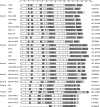Comparative analysis of complete genome sequences of three avian coronaviruses reveals a novel group 3c coronavirus
- PMID: 18971277
- PMCID: PMC2612373
- DOI: 10.1128/JVI.01977-08
Comparative analysis of complete genome sequences of three avian coronaviruses reveals a novel group 3c coronavirus
Abstract
In this territory-wide molecular epidemiology study of coronaviruses (CoVs) in Hong Kong involving 1,541 dead wild birds, three novel CoVs were identified in three different bird families (bulbul CoV HKU11 [BuCoV HKU11], thrush CoV HKU12 [ThCoV HKU12], and munia CoV HKU13 [MuCoV HKU13]). Four complete genomes of the three novel CoVs were sequenced. Their genomes (26,396 to 26,552 bases) represent the smallest known CoV genomes. In phylogenetic trees constructed using chymotrypsin-like protease (3CL(pro)), RNA-dependent RNA polymerase (Pol), helicase, spike, and nucleocapsid proteins, BuCoV HKU11, ThCoV HKU12, and MuCoV HKU13 formed a cluster distantly related to infectious bronchitis virus and turkey CoV (group 3a CoVs). For helicase, spike, and nucleocapsid, they were also clustered with a CoV recently discovered in Asian leopard cats, for which the complete genome sequence was not available. The 3CL(pro), Pol, helicase, and nucleocapsid of the three CoVs possessed higher amino acid identities to those of group 3a CoVs than to those of group 1 and group 2 CoVs. Unique genomic features distinguishing them from other group 3 CoVs include a distinct transcription regulatory sequence and coding potential for small open reading frames. Based on these results, we propose a novel CoV subgroup, group 3c, to describe this distinct subgroup of CoVs under the group 3 CoVs. Avian CoVs are genetically more diverse than previously thought and may be closely related to some newly identified mammalian CoVs. Further studies would be important to delineate whether the Asian leopard cat CoV was a result of interspecies jumping from birds, a situation analogous to that of bat and civet severe acute respiratory syndrome CoVs.
Figures




Similar articles
-
Coronavirus diversity, phylogeny and interspecies jumping.Exp Biol Med (Maywood). 2009 Oct;234(10):1117-27. doi: 10.3181/0903-MR-94. Epub 2009 Jun 22. Exp Biol Med (Maywood). 2009. PMID: 19546349 Review.
-
Comparative analysis of twelve genomes of three novel group 2c and group 2d coronaviruses reveals unique group and subgroup features.J Virol. 2007 Feb;81(4):1574-85. doi: 10.1128/JVI.02182-06. Epub 2006 Nov 22. J Virol. 2007. PMID: 17121802 Free PMC article.
-
Detection of a novel and highly divergent coronavirus from asian leopard cats and Chinese ferret badgers in Southern China.J Virol. 2007 Jul;81(13):6920-6. doi: 10.1128/JVI.00299-07. Epub 2007 Apr 25. J Virol. 2007. PMID: 17459938 Free PMC article.
-
Discovery of seven novel Mammalian and avian coronaviruses in the genus deltacoronavirus supports bat coronaviruses as the gene source of alphacoronavirus and betacoronavirus and avian coronaviruses as the gene source of gammacoronavirus and deltacoronavirus.J Virol. 2012 Apr;86(7):3995-4008. doi: 10.1128/JVI.06540-11. Epub 2012 Jan 25. J Virol. 2012. PMID: 22278237 Free PMC article.
-
Coronaviruses in poultry and other birds.Avian Pathol. 2005 Dec;34(6):439-48. doi: 10.1080/03079450500367682. Avian Pathol. 2005. PMID: 16537157 Review.
Cited by
-
Presence of Alphacoronavirus in Tree- and Crevice-Dwelling Bats from Portugal.Viruses. 2024 Mar 12;16(3):434. doi: 10.3390/v16030434. Viruses. 2024. PMID: 38543799 Free PMC article.
-
NLRP1 restricts porcine deltacoronavirus infection via IL-11 inhibiting the phosphorylation of the ERK signaling pathway.J Virol. 2024 Mar 19;98(3):e0198223. doi: 10.1128/jvi.01982-23. Epub 2024 Feb 27. J Virol. 2024. PMID: 38411106 Free PMC article.
-
Comparative genomics of spike, envelope, and nucleocapsid protein of severe acute respiratory syndrome coronavirus 2.Afr Health Sci. 2023 Sep;23(3):384-399. doi: 10.4314/ahs.v23i3.45. Afr Health Sci. 2023. PMID: 38357143 Free PMC article.
-
New Short RNA Motifs Potentially Relevant in the SARS-CoV-2 Genome.Curr Genomics. 2023 Feb 14;23(6):424-440. doi: 10.2174/1389202924666230202152351. Curr Genomics. 2023. PMID: 37920558 Free PMC article.
-
Emerging and Novel Viruses in Passerine Birds.Microorganisms. 2023 Sep 20;11(9):2355. doi: 10.3390/microorganisms11092355. Microorganisms. 2023. PMID: 37764199 Free PMC article. Review.
References
-
- Apweiler, R., T. K. Attwood, A. Bairoch, A. Bateman, E. Birney, M. Biswas, P. Bucher, L. Cerutti, F. Corpet, M. D. Croning, R. Durbin, L. Falquet, W. Fleischmann, J. Gouzy, H. Hermjakob, N. Hulo, I. Jonassen, D. Kahn, A. Kanapin, Y. Karavidopoulou, R. Lopez, B. Marx, N. J. Mulder, T. M. Oinn, M. Pagni, F. Servant, C. J. Sigrist, and E. M. Zdobnov. 2001. The InterPro database, an integrated documentation resource for protein families, domains and functional sites. Nucleic Acids Res. 2937-40. - PMC - PubMed
Publication types
MeSH terms
Substances
Associated data
- Actions
- Actions
- Actions
- Actions
LinkOut - more resources
Full Text Sources
Other Literature Sources
Miscellaneous

